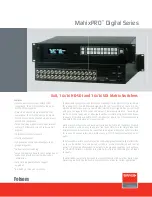
8.
If a standalone switch already has stack groups configured.
Attach cables to connect the ports already configured as stack groups on the switch to one or more
switches in the stack.
Dell Networking OS automatically assigns a number to the new unit and adds it as member switch in
the stack. The new unit synchronizes its running and startup configurations with the stack.
Dell Networking OS Behavior
: When you add a switch to a stack
• If you configure the new unit with a stack number that is already assigned to a stack member, the
stack avoids a numbering conflict by assigning the new switch the first available stack number.
• If the stack has been provisioned for the stack number that is assigned to the new unit, the pre-
configured provisioning must match the switch type. If there is a conflict between the provisioned
switch type and the new unit, a mismatch error message is displayed.
Merge Two S-Series Stacks
You may merge two stacks while they are powered and online.
To merge two stacks, connect one stack to the other using user port cables from the front end user port.
• Dell Networking OS selects a master stack manager from the two existing managers based on the
priority of the stack.
• Dell Networking OS resets all the units in the losing stack; they all become stack members.
• If there is no unit numbering conflict, the stack members retain their previous unit numbers.
Otherwise, the stack manager assigns new unit numbers, based on the order that they come online.
• The stack manager overwrites the startup and running config on the losing stack members with its
own to synchronize the configuration on the new stack members.
Split an S-Series Stack
To split a stack, unplug the desired stacking cables.
You may do this at any time, whether the stack is powered or unpowered, and the units are online or
offline. Each portion of the split stack retains the startup and running configuration of the original stack.
For a parent stack that is split into two child stacks, A and B, each with multiple units:
• If one of the new stacks receives the master and the standby management units, it is unaffected by
the split.
• If one of the new stacks receives only the master unit, that unit remains the stack manager, and Dell
Networking OS elects a new standby management unit.
• If one of the new stacks receives only the standby unit, it becomes the master unit of the new stack,
and Dell Networking OS elects a new standby unit.
• If one of the new stacks receives neither the master nor the standby management unit, the stack is
reset so that a new election can take place.
S-Series Stacking Configuration Tasks
The following are configuration tasks for the S-Series.
•
Assigning Unit Numbers to Units in an S-Series Stack
968
Stacking
Summary of Contents for S4820T
Page 1: ...Dell Configuration Guide for the S4820T System 9 8 0 0 ...
Page 282: ...Dell 282 Control Plane Policing CoPP ...
Page 622: ...Figure 81 Configuring Interfaces for MSDP 622 Multicast Source Discovery Protocol MSDP ...
Page 623: ...Figure 82 Configuring OSPF and BGP for MSDP Multicast Source Discovery Protocol MSDP 623 ...
Page 629: ...Figure 86 MSDP Default Peer Scenario 2 Multicast Source Discovery Protocol MSDP 629 ...
Page 630: ...Figure 87 MSDP Default Peer Scenario 3 630 Multicast Source Discovery Protocol MSDP ...
Page 751: ...10 11 5 2 00 00 05 00 02 04 Member Ports Te 1 2 1 PIM Source Specific Mode PIM SSM 751 ...
Page 905: ...Figure 112 Single and Double Tag First byte TPID Match Service Provider Bridging 905 ...
Page 979: ...6 Member not present 7 Member not present Stacking 979 ...
Page 981: ...storm control Storm Control 981 ...
Page 1103: ...Figure 134 Setup OSPF and Static Routes Virtual Routing and Forwarding VRF 1103 ...
















































